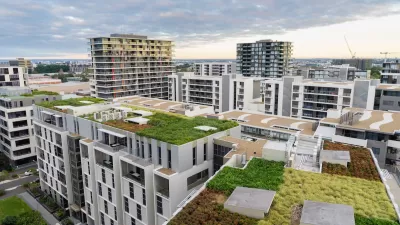Walmart stores -- once vilified by cities for their impact on local smaller retailers -- are now getting the red carpet treatment from some urban cities. Walmart has adapted its store design, and cities need the tax revenue from large retailers.
Urban downtowns have become the "last frontier" for big-box retailers. Where big-box retailers were once blocked from locating urban cities, the trend is changing. Walmart's focus on green practices, its adoption of fresh and healthy food initiatives, a willingness to abandon its suburban big box design approaches, and many cities' need for new tax revenues has enabled the company to make substantial inroads in urban areas across the country. In addition, many commercial real estate companies are benefiting from acquiring the 30,000-to-270,000-square-foot spaces where value retailers were previously not welcome.
Joel Groover writes in the December, 2011 issue of Shopping Centers Today: "Indeed, Walmart appears eager to take advantage of this newfound openness among cities toward discount retail. Rather than hunt for acreage on the outskirts of major metropolitan areas, the company is pushing to build smaller-format concepts within the city limits of such dense population centers as Chicago, Miami, New York City and Washington, observers say. Thus far, the discounter has announced plans to build a total of nine stores in Chicago alone. The first of these, a 10,000-square-foot Walmart Express, opened in the Chatham neighborhood of Chicago's South Side in July. Unlike in years past, local criticism of these plans was muted, Weinstock says, and the new store is already doing well."
Another excerpt from the article:
"For their part, big-box retailers are just as eager to find new customers, even if that means letting go of their attachment to suburban development models, McMahon says. Indeed, the stalled housing market and the oversupply of retail in the suburbs and exurbs has made cities all the more attractive to big-box stores, he says. "We now have 1.1 billion acres of vacant retail, mostly in big-box stores out on the strip, and some people believe that up to 300 million square feet of that will have to be demolished or repurposed," McMahon said. "Retailers are figuring out that inner cities are the one place in America with more spending power than stores. For the big-box industry, our downtowns are the last frontier."
"Best Buy, HHGregg and Home Depot have also been taking advantage of these lowered entry barriers in urban markets, McMahon says. Increasing flexibility with regard to store formats and sizes, a trend that has been growing for years now, has helped make the transition easier, he says. "The new Home Depot in Vancouver [British Columbia] has five stories of condo on top of it," McMahon said."
[Editor's note: This article is only available to members of the International Council of Shopping Centers (ICSC), who have access to the publication, Shopping Centers Today. Planetizen's policy is to curate articles our readers can access on the Web. However, in some cases -- when we feel an article is particularly relevant to the urban planning community -- we let our readers know about the article even if it is not available for free. Let us know what you think of our policy.]
FULL STORY: Love at second sight

Depopulation Patterns Get Weird
A recent ranking of “declining” cities heavily features some of the most expensive cities in the country — including New York City and a half-dozen in the San Francisco Bay Area.

Pennsylvania Mall Conversion Bill Passes House
If passed, the bill would promote the adaptive reuse of defunct commercial buildings.

California Exodus: Population Drops Below 39 Million
Never mind the 40 million that demographers predicted the Golden State would reach by 2018. The state's population dipped below 39 million to 38.965 million last July, according to Census data released in March, the lowest since 2015.

Google Maps Introduces New Transit, EV Features
It will now be easier to find electric car charging stations and transit options.

Ohio Lawmakers Propose Incentivizing Housing Production
A proposed bill would take a carrot approach to stimulating housing production through a grant program that would reward cities that implement pro-housing policies.

Chicago Awarded $2M Reconnecting Communities Grant
Community advocates say the city’s plan may not do enough to reverse the negative impacts of a major expressway.
City of Costa Mesa
Licking County
Barrett Planning Group LLC
HUD's Office of Policy Development and Research
Mpact Transit + Community
HUD's Office of Policy Development and Research
City of Universal City TX
ULI Northwest Arkansas
Town of Zionsville
Urban Design for Planners 1: Software Tools
This six-course series explores essential urban design concepts using open source software and equips planners with the tools they need to participate fully in the urban design process.
Planning for Universal Design
Learn the tools for implementing Universal Design in planning regulations.


























